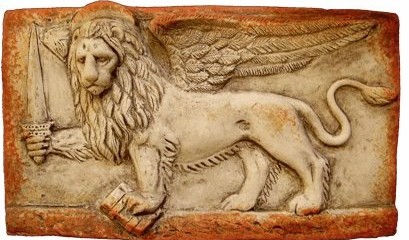Venice- Lion of St. Mark
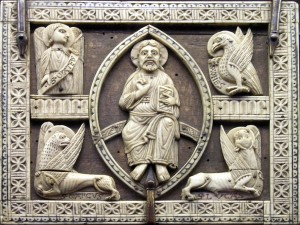
The lion became the symbol of the St.Mark because his Gospel begins like that :” remember the voice of the Baptist in the wilderness ,rises like a roar , announcing the coming of Jesus to men “; well, the lion quickly became also the symbol of the Serenissima.
St. Irenaeus , Bishop of Lyons , interprets the four living Tetramorph ( symbols of Middle Eastern origin ) as symbols of the four Evangelists : Mark ( the winged lion ) , Luke ( who later became the bull calf ) , Matthew ( the winged man ) and John ( the eagle ) .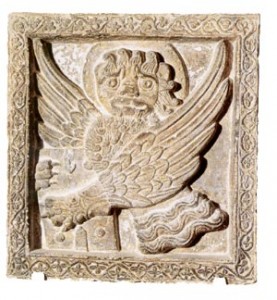
In Venice the symbolism of the lion of St. Mark comes from an ancient tradition
, according to which St. Mark’s going to Alexandria in order to convert the infidels of
that country, on a dark stormy night, his ship was boarded, seek shelter in one of the fishermen’s huts on the island, “called Rialto”. After a frugal dinner with the fishermen the saint leaned on the ground,fell asleep and in the dream he saw an angel ” of a winged lion form ” who thus spoke to him , “On this island ,a wonderful city will rise and in this great day you will find your final resting place , and you will find the final peace <Pax tibi , Marce , Evangelista meus.Hic requiescet corpus tuum >. ” ( Peace to you , Mark, my evangelist . shall rest here your body. ) ” . Mark woke up in the morning and told his dream to the fishermen , before setting sail again to the Egypt, where he died .
The book, often mistakenly associated with the Gospel , reproduce the words of welcome from the lion , in most of the representations and , is usually open ,bearing the Latin inscription ” PAX TIBI SPEED EVANGELISTA Mevs »
 The body of St. Mark was smuggled by two venecians traders,in a basket of vegetables and pork, to escape of the Muslim guards . One story tell us that when they arrived in Venice from Egypt, Alexandria (where Mark had founded the first Christian church ) ,in the year 828 , a huge crowd waiting for them , and when they set foot on the ground, an intense scent of roses spread to the pier .
The body of St. Mark was smuggled by two venecians traders,in a basket of vegetables and pork, to escape of the Muslim guards . One story tell us that when they arrived in Venice from Egypt, Alexandria (where Mark had founded the first Christian church ) ,in the year 828 , a huge crowd waiting for them , and when they set foot on the ground, an intense scent of roses spread to the pier .
Piazza San Marco
With the arrival of the St. Mark’s body and the building of the first Basilica (St. Mark’s ), the area began to assume its characteristic of monumental heart of the city.In front of the big channel on a pedestal houses the statues of Todaro , ( Theodore ) first saint patron of the city, slaying the dragon, and St. Mark, depicted as a winged lion,a very old sculpture .
The lion , raised , such as S. Theodore, on a column of Egyptian granite with medieval capital , depicts a bronze winged lion (perhaps a gilded once ) , with full mane advancing with open jaws .The earliest mention is in 1293 , (however, is already talk of restorations) , but the column on which seat was brought to Venice in 1172 , between these two dates ( mid-thirteenth century . approximately ) must be the placement of the lion.It was removed by Napoleon, who placed him in the Place des Invalides in Paris , and returned to Venice in 1815 , when it fell, and broke into many pieces, and was restored .
It was believed originally to be a ” chimera “to which were added the wings, then Romanesque , Assyrian , Indian , Chinese and Sassanian ,statue,but there is reason to believe that , like other ancient Venetian statues come from Constantinople or from the Levant .
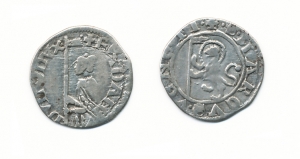 During the Republic of Venice , the Lion was represented everywhere ; outside the buildings, as the stone statues , inside of them, on frescoes and paintings ,to decorate columns and standard-bearer,on coins and , of course, on banners and flags .
During the Republic of Venice , the Lion was represented everywhere ; outside the buildings, as the stone statues , inside of them, on frescoes and paintings ,to decorate columns and standard-bearer,on coins and , of course, on banners and flags .
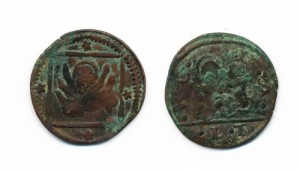
The spread of the winged lion , in territories subject to the Serenissima , make it become one of the few symbols ,wellknown throughout the world as the Lion of St. Mark
The Lion of St. Mark ( “Marciano” lion or winged lion of St. Mark ) with the closed book that was performed in a time when Venice was at war and so was contrary to the word ” Pax ” (” Peace “), ( so the winged lion , the 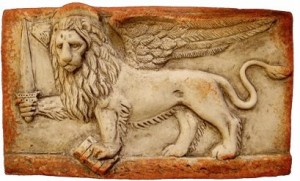 symbol representing St. Mark the Evangelist could not keep open the Gospel with the words Pax Tibi Marce Evangelista Meus ) is a legend not founded.
symbol representing St. Mark the Evangelist could not keep open the Gospel with the words Pax Tibi Marce Evangelista Meus ) is a legend not founded.
In fact the book, always closed with clips and sometimes in plain sight, was the norm until the second half of the the fourteenth century , throughout the Gothic Age .
The winged lion with the book closed was also the symbol of the ” Magistrate of the Health ” at the time of the Serenissima.
this is also all the ‘ classic iconography of Leo, is in fact rests on the ground that
at sea , holding up the book (open) with the written classical , it is ” Andante ” with the background of the Doge’s Palace and the Laguna , is , in essence , a perfect synthesis of what Leo meant for the Serenissima .
lion in moeca
” Moleca ” in Venetian dialect means ” crab ” : the feathers of the wings of the type of lion said” In moleca ” seem to open itself up as claws.In fact seems to emerge from the water, and so carries an additional ideological message , referring to the purity of Venice, born from the sea , free from political interference from nearby territorial powers .
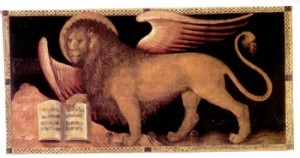 “lion with open book” ,is a paint exposed in an office of a judiciary in S.Mark.
“lion with open book” ,is a paint exposed in an office of a judiciary in S.Mark.
The writing on open book says :
” Linquitur odium hic et metus omnis rebus ardor ” and ” Plectitur hicque scelus libratum cuspide veri” which means :
” Here you leave aside hatred , jealousy and every impetuosity ” and ” Here will be punished the crime balanced on the needle of truth ”
The lions from the entrance of the Arsenale
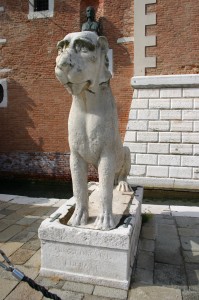 The oldest of the four lions is to the right of the entrance of the Arsenale .
The oldest of the four lions is to the right of the entrance of the Arsenale .
The most immediate comparison is with the lions of the agora of Delos , dated by the middle of the seventh century . a. C. , which this lion must belong .
The most important perhaps , but each of the lions has interesting story , one coming from sacred island of Delos, in the archipelago of the Cyclades Islands in Greece ( the second to last on the right front door, Arsenal ) , dated the sixth century BC, in memory of the Venetian conquest of Corfu in 1716.
Of different origin and age the lion comes to the left of the entrance , according to the inscription that accompanies it,come from Piraeus, and the body has two inscriptions in runic characters , memories of Scandinavian mercenaries ( Varangi ) that in 1040 , in the service of Byzantium, were sent to quell an insurrection in Athens.The lion was a well-known monument of Piraeus, was there from the first or second century . His fame was such that the Italians called the Piraeus,the Port of the Lion.
The lion statue , white marble and approximately 3 meters high , is carved in Pentelic marble , which is well known , it was not used for the construction of artistic monuments before the time of Pericle. As some art historians said this lion can be dated back to the fifth century BC.
The first traces of human presence in the Veneto region date back to the Lower Paleolithic .The objects are present in many places , the most important in “Riparo Tagliente” in Valpantena . Here, in a grave,was found a stone engraved with the figure of a lion , stirring so the legend of the Lion of San Marco with its prehistory .
other items:http://dipoco.altervista.org/articles/
visit my website http://ginocosta.altervista.org/
